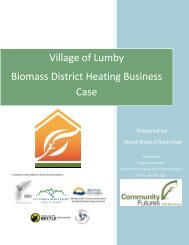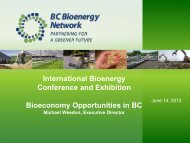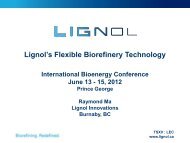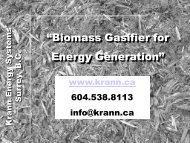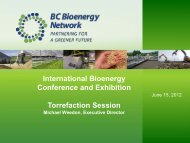Batch Oxidation System - International Bioenergy Conference and ...
Batch Oxidation System - International Bioenergy Conference and ...
Batch Oxidation System - International Bioenergy Conference and ...
Create successful ePaper yourself
Turn your PDF publications into a flip-book with our unique Google optimized e-Paper software.
Waste to Energy Canada, Inc.<br />
Environmental <strong>and</strong> Socioeconomic Solutions<br />
<strong>Batch</strong> <strong>Oxidation</strong> <strong>System</strong> (BOS)<br />
Two-Stage Advanced Thermal Gasifier<br />
Overview<br />
This document <strong>and</strong> the information presented is confidential <strong>and</strong> proprietary <strong>and</strong> may not be released to third parties without the express, written consent of Waste<br />
to Energy Canada Inc. © WTEC 2012
WTEC<br />
• WTEC is a private Canadian based OEM with their core business <strong>and</strong> expertise in the<br />
design <strong>and</strong> manufacturing of Patented <strong>and</strong> Proprietary Advanced Thermal Treatment of<br />
non-Homogenous <strong>and</strong> Homogenous waste streams.<br />
• Technology has 15 successful years of commercial deployment <strong>and</strong> technical advancement.<br />
• WTEC is a leader in the Advanced Thermal Treatment of waste <strong>and</strong> excels at process<br />
design <strong>and</strong> project execution, taking a holistic approach with each client.<br />
• WTEC maintains an international presence with key strategic partners in EPC, EPCM,<br />
Finance, <strong>and</strong> Government. Offices in BC, Alberta <strong>and</strong> UK.<br />
• Additionally, WTEC draws on a vast network of global technology partners <strong>and</strong> specialists<br />
which continuously provide us with up to date dialogue on technology advances <strong>and</strong><br />
current courses of action within the Solid Waste Treatment industry. Our modular <strong>and</strong><br />
scalable design platform allows us to design <strong>and</strong> deploy treatment systems that fit our<br />
clients dem<strong>and</strong>s.<br />
• WTEC has established a close relationships with our clients due to our “knowledge to<br />
share” philosophy.<br />
©WTEC 2012
Advanced Thermal Gasification<br />
‣ Modular <strong>and</strong> scalable in design, centralized or decentralized.<br />
‣ <strong>Batch</strong> or continuous.<br />
‣ Robust, simple to operate, low O&M, low cap, long service life.<br />
‣ Unsorted <strong>and</strong> unprocessed solid wastes are gasified by exothermic reaction at<br />
moderate temperature under quiescent, air-starved conditions in Primary<br />
Gasification Chambers to produce hot, energy-rich synthetic gas (“syngas”).<br />
‣ Liquid waste fuels can be injected separately into BOS.<br />
‣ Small amount of fuel to start process, self sustaining reaction.<br />
‣ Heat energy in the form of hot flue gas can be recovered as process heat or<br />
steam for industry or district heating <strong>and</strong>/or used to produce electricity, central<br />
chilling, <strong>and</strong>/or desalinated water.<br />
©WTEC 2012
Shortlist of Acceptable<br />
Solid Waste Types:<br />
‣ Municipal solid waste<br />
‣ Wood fiber<br />
‣ Industrial & commercial<br />
‣ Construction & demolition<br />
‣ Medical & pharmaceutical<br />
‣ Tires (whole or shredded)<br />
‣ Fish <strong>and</strong> animal remains<br />
‣ Wastewater bio-solids (sludge)<br />
‣ Biomass crops<br />
‣ Hazardous waste<br />
©WTEC 2012
©WTEC 2012
Mobile Gasification <strong>System</strong><br />
The mBOS is a mobile version of the sBOS.<br />
Perfect for remote locations, rapid response, <strong>and</strong> industrial sites<br />
©WTEC 2012
Low Impact<br />
Low-Profile Building, Small<br />
Site Footprint, Modest Stack<br />
Height.<br />
‣Site footprint 0.7 hectares (1.75<br />
acres)<br />
‣Building area 5400 m2(1.3<br />
acres)<br />
Stack Height: 20 m (65 ft)<br />
©WTEC 2012
Monitoring Results for Dioxins & Furans at Scotl<strong>and</strong><br />
cBOS Plant Compared to EU Limits<br />
Independent tests show emissions at only 35% of stringent EU limits.<br />
©WTEC 2012
First Nations<br />
Dynamic<br />
communities, ownership, traditions, respect, holistic<br />
approach.<br />
• Ahousaht<br />
• Kelly Lake Metis Society<br />
• Vuntut Gwitchin<br />
• Tl’azt’en Nation<br />
©WTEC 2012
Old Crow - Yukon
Old Crow - Yukon
Tl'azt'en Nation<br />
• Parallel socioeconomic project development:<br />
• Projects owned <strong>and</strong> operated by community.<br />
• Eliminate the flow of municipal waste to the l<strong>and</strong>fill via small scale BOS<br />
• Mobile system to remediate the current l<strong>and</strong>fill – training, business model,<br />
ongoing revenue stream.<br />
• Small scale biomass gasifier located within the community providing<br />
centralized heating – school, administrative buildings, small scale<br />
greenhouse.<br />
• Large, scalable biomass gasifier located at the current sawmill location –<br />
use of current infrastructure, scaled project starting at 5MWe to grid with a<br />
growth potential to 20-30MW – PPA or private off-take.<br />
• Commercial greenhouses 3-klm diet, Silva culture.<br />
©WTEC 2012
Local <strong>and</strong> <strong>International</strong><br />
• UK - 9<br />
• Pol<strong>and</strong> - 5<br />
• Ukraine -2<br />
• Russia- 4<br />
• South America - 6<br />
• US - 2<br />
• Canada – 4<br />
Strategic Partners (capacity):<br />
• MACE<br />
• Costain<br />
• Diani<br />
• Suez/SITA<br />
• EnergyGap<br />
• EDC<br />
• 2012 Olympics<br />
• Featuring BC <strong>and</strong> Intl<br />
projects.<br />
©WTEC 2012
ROCs<br />
• The RO is the main support mechanism for renewable electricity projects in<br />
the UK. Smaller scale generation is mainly supported through the Feed-In<br />
Tariff scheme (FITs)<br />
• The RO came into effect in 2002 in Engl<strong>and</strong> <strong>and</strong> Wales <strong>and</strong> in Scotl<strong>and</strong> <strong>and</strong> in<br />
2005 in Northern Irel<strong>and</strong>. It places an obligation on UK electricity suppliers to<br />
source an increasing proportion of electricity they supply to customers from<br />
renewable sources.<br />
• Renewables Obligation Certificates (ROCs) are green certificates issued by the<br />
Authority to operators of accredited renewable generating stations for the<br />
eligible renewable electricity they generate. Operators can then trade the ROCs<br />
with other parties, with the ROCs ultimately being used by suppliers to<br />
demonstrate that they have met their obligation.<br />
• Where suppliers do not have sufficient number of ROCs to meet their<br />
obligation, they must pay an equivalent amount into a ‘buy-out’ fund. The<br />
administration cost of the scheme is recovered from the fund <strong>and</strong> the rest is<br />
distributed back to suppliers in proportion to the number of ROCs they<br />
produced in respect of their individual obligation.<br />
©WTEC 2012
Thank You<br />
©WTEC 2012
BOS Thermal Gasification<br />
Waste-to-Energy Process Flow Diagrams<br />
1 st stage: Solid waste is heated under starved-air conditions in Primary<br />
Gasification Chamber to form hot, energy rich syngas.<br />
©WTEC 2012
BOS Thermal Gasification<br />
Waste-to-Energy Process Flow Diagrams<br />
2 nd stage: Syngas is drawn into the Secondary Combustion Chamber<br />
where it burns at high temperature under excess-air conditions.<br />
©WTEC 2012
BOS Thermal Gasification<br />
Waste-to-Energy Process Flow Diagrams<br />
3 rd stage: Heat Energy in fully combusted flue gas is recovered in<br />
boiler or other heat exchanger.<br />
©WTEC 2012
BOS Thermal Gasification<br />
Waste-to-Energy Process Flow Diagrams<br />
4 th stage: Steam powers turbine generator to produce electricity.<br />
©WTEC 2012
BOS Thermal Gasification<br />
Waste-to-Energy Process Flow Diagrams<br />
5 th stage: Cooled flue gas is scrubbed by Best Available Technology.<br />
©WTEC 2012
Interior of 20 Metric Ton per Day BOS Waste-to-<br />
Energy Facility Generating Steam –Husavik Icel<strong>and</strong><br />
2 Primary Gasification Chambers (grey rectangles)<br />
1 Secondary Combustion Chamber (grey cylinder)<br />
1 heat recovery boiler (blue cylinder).<br />
In operation since 2004 ©WTEC 2012
Primary Gasification Chambers convert solid waste into hot, energyrich<br />
syngas by slow, undisturbed thermal decomposition under airstarved<br />
conditions at moderate temperature (~ 450°C). Conversion<br />
process takes 12 to 14 hours per batch. Cool down takes 6 to 8 hours.<br />
©WTEC 2012
‣Only a few gallons fuel required to start<br />
reaction in 65m3chamber.<br />
‣Self-sustaining thermal reaction turns<br />
solid waste into hot, energy-rich gases<br />
leaving behind clean, non-toxic,<br />
carbon-free ash.<br />
‣ Produces no slag or clinkers.<br />
‣ Reduces waste volume up to 97%.<br />
‣Greatly reduces particulate matter,<br />
heavy metals, NOx <strong>and</strong> other<br />
pollutants.<br />
©WTEC 2012
Hot syngas is drawn into Secondary Combustion<br />
Chamber where excess air is added to create violent<br />
combustion of syngas at temperatures up to 1300°C.<br />
Retention time ≥ 2 seconds. Energy conversion efficiency<br />
≥ 95% to the boiler.<br />
©WTEC 2012
The BOS Waste-to-Energy Solution<br />
‣Cleaner <strong>and</strong> more efficient than incineration.<br />
‣Lower emissions than central power plants.<br />
‣Eliminates Greenhouse Gases (GHGs) from l<strong>and</strong>fills <strong>and</strong><br />
reduces GHGs from power generation <strong>and</strong> other sources.<br />
‣No sorting or pre-processing of waste required.<br />
‣Bottom ash is sterile, non-toxic, virtually free of carbon, <strong>and</strong><br />
valuable as concrete aggregate.<br />
‣Cuts l<strong>and</strong>fill waste to zero or near zero.<br />
‣Increases recycling of glass <strong>and</strong> metals.<br />
‣Produces clean, renewable energy for<br />
electricity, steam, heating, cooling, <strong>and</strong> purifying water.<br />
©WTEC 2012
BOS 2-Stage Thermal Gasification Process<br />
• Unsorted <strong>and</strong> unprocessed solid wastes are gasified by exothermic<br />
reaction at moderate temperature under quiescent, starved-air<br />
conditions in Primary<br />
• Gasification Chambers to produce hot, energy-rich synthetic gas<br />
(“syngas”).<br />
• Liquid wastes can be injected separately.<br />
• Hot syngas is drawn off into Secondary Combustion Chamber<br />
where it burns cleanly <strong>and</strong> safely under excess-air conditions at<br />
temperatures up to 1300°C with retention time ≥ 2 seconds.<br />
• 24-hour batch processing in each Primary Gasification Chamber.<br />
• 4 Primary Gasification Chambers with staggered startup times<br />
supply even, continuous energy to secondary chamber.<br />
• Heat energy in the hot flue gas can be recovered as process heat or<br />
steam for industry or district heating <strong>and</strong>/or used to produce<br />
electricity, central chilling, <strong>and</strong>/or desalinated water.<br />
• Flue gas can be cleaned further to meet any emissions limits.<br />
©WTEC 2012
No Sorting or Pre-Processing of Waste Cuts Capital &<br />
Operating Costs & Downtime<br />
Loose, baled, <strong>and</strong> densified wastes can all be loaded<br />
directly into the BOS with no sorting or preprocessing.<br />
©WTEC 2012
Easy <strong>Batch</strong> Loading by Extension-Boom Loader or<br />
Automatic Conveyor<br />
15 minutes to load 15 metric tons of waste into Primary Gasification<br />
Chamber. No more labour required for 23 hours.<br />
©WTEC 2012
BOS Can Also Convert Liquid Wastes<br />
Liquid wastes can be injected into<br />
BOS to be destroyed safely while<br />
boosting energy recovery.<br />
Shortlist of Acceptable Liquid Wastes:<br />
‣ Used motor oil<br />
‣ Oil <strong>and</strong> latex paints<br />
‣ Organic solvents<br />
‣ Anti-freeze<br />
‣ Transformer fluid<br />
‣ Organic refrigerants & propellants<br />
‣Persistent Organic Pollutants<br />
(POPs) such as pesticides &<br />
herbicides in liquid or solid form<br />
©WTEC 2012
BOS Bottom Ash<br />
Sterile.<br />
Non-toxic.<br />
Virtually no carbon.<br />
Passes EPA’s “Toxicity<br />
Characteristics Leaching<br />
Procedure” test.<br />
Can be sold as aggregate<br />
for concrete <strong>and</strong> asphalt<br />
road surfacing.<br />
L<strong>and</strong>filling not required.<br />
©WTEC 2012
BOS Increases Recycling of Metals <strong>and</strong> Glass<br />
Glass <strong>and</strong> metals<br />
are not melted<br />
Metals can easily<br />
be compacted on<br />
site for safe <strong>and</strong><br />
economical<br />
transport.<br />
Glass is also<br />
crushed <strong>and</strong><br />
bagged on site.<br />
Metal <strong>and</strong> glass can be recovered from bottom ash for<br />
recycling. White color of ash shows it is virtually free of<br />
carbon.<br />
©WTEC 2012
Easy Removal of Bottom Ash<br />
& Recyclables after Cool Down<br />
Bottom ash together with metals <strong>and</strong> glass recovered for<br />
recycling can be scooped out front door or removed by<br />
automatic conveyor.<br />
©WTEC 2012
Energy Recovery<br />
Heat energy can be recovered in boiler (low-pressure boiler<br />
shown above), Organic Rankine Cycle (ORC) turbine generator,<br />
absorption chiller, or flue-gas-to-air heat exchanger.<br />
Recovered energy can be used for industrial processes,<br />
heating <strong>and</strong> cooling, generating electricity, <strong>and</strong> desalination.<br />
©WTEC 2012
Research <strong>and</strong> Development<br />
A key focal point for WTEC is R&D. We are continuously looking for ways to<br />
further incorporate our technology into closed loop sequestering while providing<br />
increased socioeconomic value to communities while driving out costs.<br />
‣ Greenhouses: excess heat providing free<br />
energy <strong>and</strong> nutrients (scrubbed C02) to<br />
community or commercial scale<br />
greenhouses. 100-mile diet.<br />
‣ Photo Bioreactors:<br />
Excess heat <strong>and</strong> scrubbed C02 for<br />
Pharmaceutical grade Algae production.<br />
Low capital <strong>and</strong> skilled labour options –high<br />
revenue.<br />
‣ Direct fire : refining options for utilizing<br />
syngas in direct fire engines<br />
©WTEC 2012
Indicative Energy Recovery <strong>and</strong> Electric Power<br />
Generation<br />
Type of Waste<br />
Metric Tonnes of Steam/hr<br />
per metric Tonne of Waste<br />
Municipal 2.4 tonnes 430 kW hrs<br />
50% Municipal<br />
3.6 tonnes 650 kW hrs<br />
50% Industrial<br />
Packaging 4.7 tonnes 850 kW hrs<br />
Tires <strong>and</strong> Industrial Plastics 9.4 tonnes 1700 kW hrs<br />
Kilowatt hrs of Electricity<br />
per Metric Tonne of Waste<br />
Actual energy recovery <strong>and</strong> power generation depends on<br />
calorific value <strong>and</strong> moisture content of waste, types of<br />
power technology selected, their design <strong>and</strong><br />
configuration, <strong>and</strong> other factors.<br />
©WTEC 2012
Clean Air Emissions<br />
160<br />
140<br />
120<br />
100<br />
80<br />
US ≤ 250 tpdl<br />
US > 250 tpd<br />
Scotl<strong>and</strong> cBOS 200<br />
tpd<br />
60<br />
40<br />
20<br />
0<br />
PM<br />
mg/dscm<br />
HCl<br />
ppmdv<br />
NO2<br />
ppmdv<br />
SO2<br />
ppmdv<br />
CO<br />
ppmv<br />
BOS emissions pass all EPA tests in US & European.<br />
BOS waste-to-energy facilities can be designed to achieve<br />
even lower emissions that those shown here.<br />
©WTEC 2012
Example of Design Basis for Emissions at New<br />
Scotl<strong>and</strong> cBOS Facility Compared to EU Limits<br />
Substance<br />
BOS<br />
Design Basis<br />
Maximum Limits<br />
EU Regulations<br />
Particulate Matter (PM) < 5 mg / Nm 3 10 mg / Nm 3<br />
Nitrogen Oxides (NO x ) < 90 mg / Nm 3 200 mg / Nm 3<br />
Carbon Monoxide (CO) < 8 mg / Nm 3 50 mg / Nm 3<br />
Sulphur Dioxide (SO 2 ) < 10 mg / Nm 3 50 mg / Nm 3<br />
Total Organic Carbon (TOC) < 2 mg / Nm 3 10 mg / Nm 3<br />
Hydrogen Chloride (HCl) < 3 mg / Nm 3 10 mg / Nm 3<br />
Dioxin & Furans < 0,08 ng / Nm 3 0,10 ng / Nm 3<br />
BOS plants can also be designed to achieve even lower emissions.<br />
©WTEC 2012
Monitoring Results for Dioxins & Furans at Scotl<strong>and</strong><br />
cBOS Plant Compared to EU Limits<br />
Independent tests show emissions at only 35% of stringent EU limits.<br />
©WTEC 2012
Flue Gas Treatment <strong>System</strong><br />
Inherently low BOS emissions are further<br />
reduced by advanced treatment of flue gases:<br />
View of stack with BOS<br />
operating at full capacity<br />
Flue gas retention time ≥2<br />
sec at temps up to 1300°C.<br />
Sodium bicarbonate to<br />
neutralize acids.<br />
Activated carbon to remove<br />
trace dioxins, furans, <strong>and</strong><br />
heavy metals.<br />
Flue gas recirculation <strong>and</strong><br />
selective non-catalytic<br />
reduction (SNCR) to control<br />
NOx.<br />
Filter bag-house to collect<br />
scrubber consumables <strong>and</strong><br />
residual fly ash.<br />
©WTEC 2012
Continuous BOS (cBOS)Configuration for Continuous<br />
Power Generation<br />
cBOS Process Train with Four<br />
Primary Gasification Chambers<br />
Feeding One Secondary<br />
Combustion Chamber Provides<br />
Even, Continuous Supply of<br />
Energy<br />
Start-up times of the four Primary Gasification Chambers in each<br />
process train are staggered by six hours. This start-up schedule<br />
together with the large capacity of each Primary Gasification<br />
Chamber, the slow gasification of wastes at moderate<br />
temperature, <strong>and</strong> WTEC’s proprietary control system ensures that<br />
batch processing of a mixed <strong>and</strong> variable waste stream results in<br />
production of an even, continuous supply of energy to the power train.<br />
©WTEC 2012
Automated cBOS Process Controls<br />
‣Operator interface by touch-screen controls.<br />
‣SCADA (Supervisory Control & Data Acquisition)data<br />
logging capability.<br />
‣Real-time remote monitoring by WTEC technical<br />
staff.<br />
©WTEC 2012
Functionally Independent cBOS Process Trains<br />
Can Be Added to Achieve Desired Capacity<br />
St<strong>and</strong>ard cBOS process train with 4 Primary<br />
Gasification Chambers converts 246 m3 of solid waste.<br />
©WTEC 2012
Layout of Waste-to-Energy Facility with Three<br />
cBOS Process Trains<br />
180 metric tons per day waste-to-energy facility. First<br />
two process trains (left) recently commissioned in<br />
Scotl<strong>and</strong>. Plant can produce up to 9 MW electricity.<br />
©WTEC 2012
Interior of cBOS Waste-to-Energy Facility with<br />
Two Process Trains Installed<br />
Shown during commissioning in Scotl<strong>and</strong>, October 2009.<br />
Addition of third cBOS process train scheduled for 2010.<br />
©WTEC 2012
Advantages of Modular cBOS Plant Design<br />
Modules are pre-fabricated <strong>and</strong> tested at the factory, which<br />
cuts costs, ensures quality, <strong>and</strong> speeds installation on site.<br />
Capacity can be added or taken off line as needed.<br />
Cuts initial <strong>and</strong> life-cycle capital costs because plant can be<br />
built for near-term rather than long-term capacity needs.<br />
Cuts risk of incorrectly forecasting waste <strong>and</strong> recycling<br />
volumes.<br />
Cuts down time because maintenance <strong>and</strong> repair on one<br />
module does not affect operation of other modules.<br />
One or more cBOS process trains can be paired with each<br />
functionally independent power train to provide full<br />
redundancy.<br />
Allows cost-effective waste processing <strong>and</strong> power generation<br />
even at small capacities.<br />
©WTEC 2012
cBOS Allows<br />
De-Centralized Waste<br />
Processing &<br />
Distributed Power<br />
Generation<br />
Cuts costs <strong>and</strong> environment effects of waste hauling.<br />
Cuts or eliminates capital & operating costs of transfer stations.<br />
Allows communities to take responsibility for their own waste.<br />
Co-locate waste-to-energy plant at site of end user.<br />
No power distribution costs or line losses.<br />
©WTEC 2012
Small BOS (sBOS) with Single Primary Gasification<br />
Chamber<br />
The sBOS was developed over 15 years ago.<br />
Many sBOS installed in North America, South Pacific <strong>and</strong> the Caribbean.<br />
Energy can be recovered for 8 to 10 hours per day.<br />
©WTEC 2012
Mobile (mBOS) with Single Primary Gasification<br />
Chamber<br />
The mBOS is a mobile version of the sBOS.<br />
Perfect for remote camps, rapid response, <strong>and</strong> industrial sites<br />
©WTEC 2012
Touch-Screen Control Panel<br />
sBOS have automatic controls with manual override that operators<br />
can monitor or adjust using the simple touch-screen control panel.<br />
©WTEC 2012
BOS can be designed to manage specialized waste<br />
Ronald Reagan Ballistic Missile Defence Test Site, Kwajalein Atoll.<br />
Plant is raised to enable ash removal from bottom.<br />
©WTEC 2012
Skid-Mounted sBOS<br />
sBOS starting at from 1.0MTPD can be skid-mounted<br />
for easy delivery <strong>and</strong> installation.<br />
©WTEC 2012
sBOS Treating Complete Waste Stream at Remote Industrial Sites<br />
One of two 3.5 metric ton per day sBOS destroying industrial <strong>and</strong> municipal<br />
waste at a remote oil company site in Alaska, in operation since 1999. Note<br />
automatic waste feed conveyor at right.<br />
©WTEC 2012
All BOS Achieve Complete Destruction of Medical Waste<br />
1.0 ton sBOS processing medical waste in Cayman<br />
Isl<strong>and</strong>s, 1999.All BOS achieve complete destruction of<br />
waste in regulatory terms.<br />
©WTEC 2012
Potential BOS Revenue Streams<br />
Disposal or “tipping” fees.<br />
Electricity.<br />
Process heat to industry.<br />
Process steam to industry.<br />
Low-pressure steam for district heating.<br />
Chilled water or air for central cooling.<br />
Desalinated water.<br />
Scrap metal recovered from bottom ash.<br />
Bottom ash sold for concrete aggregate.<br />
Carbon credits.<br />
Renewable energy credits.<br />
Renewable energy grants <strong>and</strong> tax credits.<br />
©WTEC 2012
Summary of BOS Financial <strong>and</strong> Environmental<br />
Advantages<br />
Low capital cost.<br />
Low labour, fuel, <strong>and</strong> other operating costs.<br />
Very low air emissions.<br />
Cuts Greenhouse Gases.<br />
Sterile, non-toxic, low-volume bottom ash.<br />
No sanitary l<strong>and</strong>fill required for bottom ash.<br />
Increase recovery of metals <strong>and</strong> glass for recycling.<br />
Small site footprint <strong>and</strong> low stack height.<br />
Building looks much like ordinary warehouse.<br />
De-centralized waste processing cuts financial <strong>and</strong><br />
environmental costs of waste hauling <strong>and</strong> transfer stations.<br />
De-centralized waste processing allows communities<br />
to take responsibility for their own waste.<br />
©WTEC 2012
Summary of BOS Design <strong>and</strong> Operating Advantages<br />
Proven technology with commercial plants built & operating.<br />
Simple, robust design with very few moving parts.<br />
High facility availability factor.<br />
Processes a wide range of solid <strong>and</strong> liquid wastes.<br />
No sorting or pre-processing of solid waste required.<br />
High efficiency of energy conversion.<br />
Produces no slag or clinkers.<br />
Very low use of auxiliary fuel.<br />
No intermediate step of cleaning <strong>and</strong> storing syngas or RDF.<br />
Computerized controls <strong>and</strong> real-time remote monitoring.<br />
Functionally independent process trains.<br />
Process trains can be added to achieve optimum capacity.<br />
Low costs <strong>and</strong> modular design allow de-centralized<br />
Waste processing <strong>and</strong> distributed power generation.<br />
©WTEC 2012
Recent Customers<br />
US Air Force, Wake Isl<strong>and</strong> –Municipal Solid Waste, Tires <strong>and</strong><br />
Waste Oil –sBOS.<br />
Scotgen Ltd, Scotl<strong>and</strong> –Municipal <strong>and</strong> Industrial Waste –<br />
cBOS.<br />
US Department of Defence, Kwajalein Atoll, Marshall Isl<strong>and</strong>s<br />
–Municipal <strong>and</strong> Industrial Waste –cBOS.<br />
Husavik, Icel<strong>and</strong> –Municipal Solid Waste <strong>and</strong> Tires –cBOS.<br />
Cayman Isl<strong>and</strong>s –Medical Waste –sBOS.<br />
Egigik, Alaska –Municipal Solid Waste –sBOS.<br />
Gudang, Indonesia –Agricultural Waste –COR.<br />
Crow Business Services, Australia –Wood Waste –COR.<br />
©WTEC 2012



